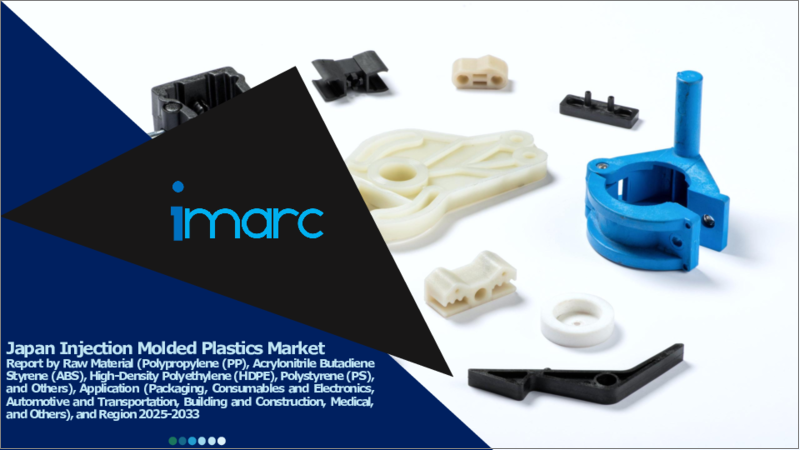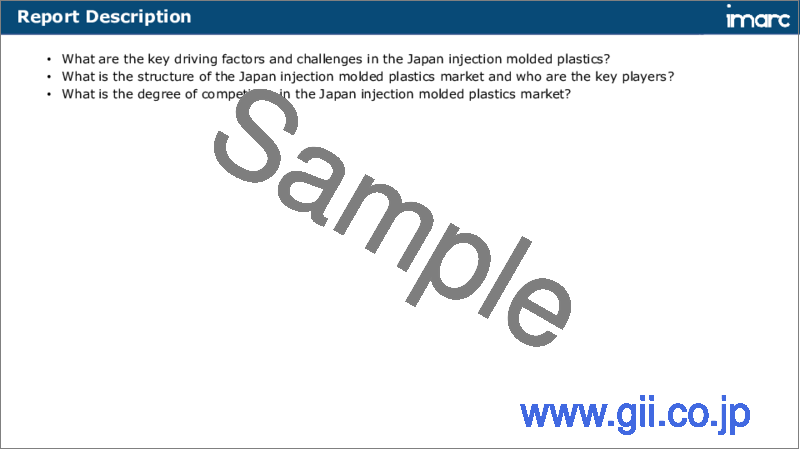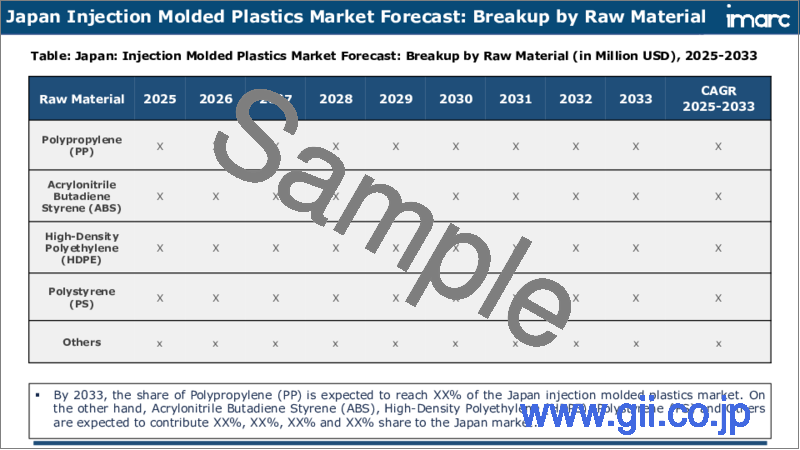|
|
市場調査レポート
商品コード
1746720
日本の射出成形プラスチック市場レポート :原材料、用途、地域別、2025年~2033年Japan Injection Molded Plastics Market Report by Raw Material (Polypropylene, Acrylonitrile Butadiene Styrene, High-Density Polyethylene, Polystyrene, and Others), Application, and Region 2025-2033 |
||||||
カスタマイズ可能
|
|||||||
| 日本の射出成形プラスチック市場レポート :原材料、用途、地域別、2025年~2033年 |
|
出版日: 2025年06月02日
発行: IMARC
ページ情報: 英文 120 Pages
納期: 5~7営業日
|
全表示
- 概要
- 目次
日本の射出成形プラスチック市場規模は2024年に186億1,200万米ドルに達しました。今後、IMARC Groupは、同市場が2033年までに252億6,900万米ドルに達し、2025~2033年の成長率(CAGR)は3.5%になると予測しています。自動車、航空宇宙、消費財などの産業で幅広い用途に利用される軽量で耐久性のある素材に対する需要の増加が、射出成形プラスチック市場を牽引しています。
本レポートで扱う主な質問
- 日本の射出成形プラスチック市場はこれまでどのように推移してきたか?
- COVID-19が日本の射出成形プラスチック市場に与えた影響は?
- 日本の射出成形プラスチック市場の原料別区分は?
- 日本の射出成形プラスチック市場の用途別区分は?
- 日本の射出成形プラスチック市場のバリューチェーンにおける様々なステージとは?
- 日本の射出成形プラスチックの主要な促進要因と課題は?
- 日本の射出成形プラスチック市場の構造と主要プレーヤーは?
- 日本の射出成形プラスチック市場における競合の程度は?
目次
第1章 序文
第2章 調査範囲と調査手法
- 調査の目的
- ステークホルダー
- データソース
- 市場推定
- 調査手法
第3章 エグゼクティブサマリー
第4章 日本の射出成形プラスチック市場- イントロダクション
- 概要
- 市場力学
- 業界動向
- 競合情報
第5章 日本の射出成形プラスチック市場情勢
- 過去および現在の市場動向(2019~2024年)
- 市場予測(2025~2033年)
第6章 日本の射出成形プラスチック市場- 原材料別の内訳
- ポリプロピレン(PP)
- アクリロニトリルブタジエンスチレン(ABS)
- 高密度ポリエチレン(HDPE)
- ポリスチレン(PS)
- その他
第7章 日本の射出成形プラスチック市場- 用途別の内訳
- パッケージ
- 消耗品と電子機器
- 自動車・輸送
- 建築・建設
- 医療
- その他
第8章 日本の射出成形プラスチック市場- 競合情勢
- 概要
- 市場構造
- 市場企業のポジショニング
- 主要成功戦略
- 競合ダッシュボード
- 企業評価象限
第9章 主要企業のプロファイル
第10章 日本の射出成形プラスチック市場- 業界分析
- 促進要因・抑制要因・機会
- ポーターのファイブフォース分析
- バリューチェーン分析
第11章 付録
Japan injection molded plastics market size reached USD 18,612.0 Million in 2024. Looking forward, IMARC Group expects the market to reach USD 25,269.0 Million by 2033, exhibiting a growth rate (CAGR) of 3.5% during 2025-2033. The increasing demand for lightweight and durable materials, which are utilized for a wide range of applications in industries, such as automotive, aerospace, and consumer goods, is driving the injection molded plastics market.
Injection molded plasticsare a versatile and widely used method of manufacturing a vast array of products across numerous industries. This process involves melting plastic pellets until they become malleable enough to be injected under pressure into a mold, which is a hollow cavity of the desired shape. Once in the mold, the plastic is allowed to cool and solidify, forming a precise and highly reproducible part. The strength of this technique lies in its efficiency and ability to produce complex shapes with great accuracy, often integrating multiple components into a single piece. Materials used in injection molding are diverse, ranging from common plastics like polyethylene and PVC to engineering plastics like polycarbonate and polyamide. Applications are virtually limitless, encompassing items from automotive components and medical devices to household products and toys. The technology's precision helps to reduce waste material, contributing to its popularity in today's cost-conscious and environmentally aware manufacturing landscape.
Japan Injection Molded Plastics Market Trends:
The injection molded plastics market in Japan is experiencing robust growth, driven by several key factors. Firstly, the increasing demand for lightweight and durable materials across various industries has propelled the market forward. Moreover, the automotive sector, in particular, has been a significant driver, with automakers opting for injection molded plastics to reduce vehicle weight and enhance fuel efficiency. Additionally, the healthcare industry's growing need for precision components and packaging solutions has spurred the adoption of injection molded plastics due to their versatility and cost-effectiveness. Furthermore, environmental concerns have played a pivotal role in the market's expansion. The push for eco-friendly materials has led to a surge in bio-based and recycled plastics, aligning with sustainability goals. Moreover, the inherent design flexibility of injection molding has made it a preferred choice for manufacturers seeking intricate and customized products, further fueling market growth. Apart from this, numerous technological advancements, such as 3D printing and Industry 4.0 integration, which continue to enhance production efficiency and quality, are expected to drive the injection molded plastics market in Japan during the forecast period.
Japan Injection Molded Plastics Market Segmentation:
Raw Material Insights:
- Polypropylene (PP)
- Acrylonitrile Butadiene Styrene (ABS)
- High-Density Polyethylene (HDPE)
- Polystyrene (PS)
- Others
Application Insights:
- Packaging
- Consumables and Electronics
- Automotive and Transportation
- Building and Construction
- Medical
- Others
Competitive Landscape:
The market research report has also provided a comprehensive analysis of the competitive landscape. Competitive analysis such as market structure, key player positioning, top winning strategies, competitive dashboard, and company evaluation quadrant has been covered in the report. Also, detailed profiles of all major companies have been provided.
Key Questions Answered in This Report:
- How has the Japan injection molded plastics market performed so far and how will it perform in the coming years?
- What has been the impact of COVID-19 on the Japan injection molded plastics market?
- What is the breakup of the Japan injection molded plastics market on the basis of raw material?
- What is the breakup of the Japan injection molded plastics market on the basis of application?
- What are the various stages in the value chain of the Japan injection molded plastics market?
- What are the key driving factors and challenges in the Japan injection molded plastics?
- What is the structure of the Japan injection molded plastics market and who are the key players?
- What is the degree of competition in the Japan injection molded plastics market?
Table of Contents
1 Preface
2 Scope and Methodology
- 2.1 Objectives of the Study
- 2.2 Stakeholders
- 2.3 Data Sources
- 2.3.1 Primary Sources
- 2.3.2 Secondary Sources
- 2.4 Market Estimation
- 2.4.1 Bottom-Up Approach
- 2.4.2 Top-Down Approach
- 2.5 Forecasting Methodology
3 Executive Summary
4 Japan Injection Molded Plastics Market - Introduction
- 4.1 Overview
- 4.2 Market Dynamics
- 4.3 Industry Trends
- 4.4 Competitive Intelligence
5 Japan Injection Molded Plastics Market Landscape
- 5.1 Historical and Current Market Trends (2019-2024)
- 5.2 Market Forecast (2025-2033)
6 Japan Injection Molded Plastics Market - Breakup by Raw Material
- 6.1 Polypropylene (PP)
- 6.1.1 Overview
- 6.1.2 Historical and Current Market Trends (2019-2024)
- 6.1.3 Market Forecast (2025-2033)
- 6.2 Acrylonitrile Butadiene Styrene (ABS)
- 6.2.1 Overview
- 6.2.2 Historical and Current Market Trends (2019-2024)
- 6.2.3 Market Forecast (2025-2033)
- 6.3 High-Density Polyethylene (HDPE)
- 6.3.1 Overview
- 6.3.2 Historical and Current Market Trends (2019-2024)
- 6.3.3 Market Forecast (2025-2033)
- 6.4 Polystyrene (PS)
- 6.4.1 Overview
- 6.4.2 Historical and Current Market Trends (2019-2024)
- 6.4.3 Market Forecast (2025-2033)
- 6.5 Others
- 6.5.1 Historical and Current Market Trends (2019-2024)
- 6.5.2 Market Forecast (2025-2033)
7 Japan Injection Molded Plastics Market - Breakup by Application
- 7.1 Packaging
- 7.1.1 Overview
- 7.1.2 Historical and Current Market Trends (2019-2024)
- 7.1.3 Market Forecast (2025-2033)
- 7.2 Consumables and Electronics
- 7.2.1 Overview
- 7.2.2 Historical and Current Market Trends (2019-2024)
- 7.2.3 Market Forecast (2025-2033)
- 7.3 Automotive and Transportation
- 7.3.1 Overview
- 7.3.2 Historical and Current Market Trends (2019-2024)
- 7.3.3 Market Forecast (2025-2033)
- 7.4 Building and Construction
- 7.4.1 Overview
- 7.4.2 Historical and Current Market Trends (2019-2024)
- 7.4.3 Market Forecast (2025-2033)
- 7.5 Medical
- 7.5.1 Overview
- 7.5.2 Historical and Current Market Trends (2019-2024)
- 7.5.3 Market Forecast (2025-2033)
- 7.6 Others
- 7.6.1 Historical and Current Market Trends (2019-2024)
- 7.6.2 Market Forecast (2025-2033)
8 Japan Injection Molded Plastics Market - Competitive Landscape
- 8.1 Overview
- 8.2 Market Structure
- 8.3 Market Player Positioning
- 8.4 Top Winning Strategies
- 8.5 Competitive Dashboard
- 8.6 Company Evaluation Quadrant
9 Profiles of Key Players
- 9.1 Company A
- 9.1.1 Business Overview
- 9.1.2 Product Portfolio
- 9.1.3 Business Strategies
- 9.1.4 SWOT Analysis
- 9.1.5 Major News and Events
- 9.2 Company B
- 9.2.1 Business Overview
- 9.2.2 Product Portfolio
- 9.2.3 Business Strategies
- 9.2.4 SWOT Analysis
- 9.2.5 Major News and Events
- 9.3 Company C
- 9.3.1 Business Overview
- 9.3.2 Product Portfolio
- 9.3.3 Business Strategies
- 9.3.4 SWOT Analysis
- 9.3.5 Major News and Events
- 9.4 Company D
- 9.4.1 Business Overview
- 9.4.2 Product Portfolio
- 9.4.3 Business Strategies
- 9.4.4 SWOT Analysis
- 9.4.5 Major News and Events
- 9.5 Company E
- 9.5.1 Business Overview
- 9.5.2 Product Portfolio
- 9.5.3 Business Strategies
- 9.5.4 SWOT Analysis
- 9.5.5 Major News and Events
10 Japan Injection Molded Plastics Market - Industry Analysis
- 10.1 Drivers, Restraints, and Opportunities
- 10.1.1 Overview
- 10.1.2 Drivers
- 10.1.3 Restraints
- 10.1.4 Opportunities
- 10.2 Porters Five Forces Analysis
- 10.2.1 Overview
- 10.2.2 Bargaining Power of Buyers
- 10.2.3 Bargaining Power of Suppliers
- 10.2.4 Degree of Competition
- 10.2.5 Threat of New Entrants
- 10.2.6 Threat of Substitutes
- 10.3 Value Chain Analysis





